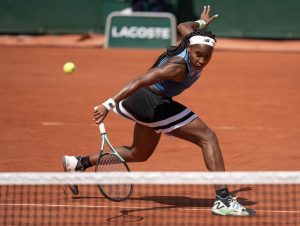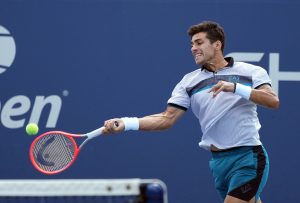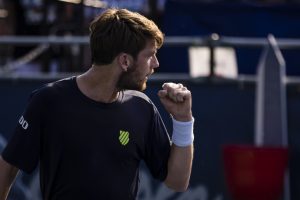With Wimbledon about to start – for the first time in two years – Martin Keady, our resident tennis historian, looks back at the five finest Men’s Single Champions in the history of the world’s greatest tennis tournament. Martin also takes a look at the five greatest Wimbledon women’s champions including Serena Williams.
Wimbledon 2020 never happened, mainly because Wimbledon was seemingly the only major sporting event or institution in the world that actually had pandemic insurance. Consequently, it did not have go ahead without any spectators at all (as in the case of the US Open) or with only very few spectators (as in the case of the French Open). Instead, it could take “the hit” and hope to come back stronger this year. As a result, the grass at Wimbledon will surely never ever have looked as green as it will on Monday, when Wimbledon 2021 begins.
And here, in ascending order, are the five finest male champions ever to bestride that grass.
- Rod Laver: Four-Time Champion (1961, 1962, 1968, 1969)
In all the current discussion about who exactly is the GOAT (Greatest of All Time) among The Gigantic Three of Roger Federer, Rafael Nadal and Novak Djokovic, it is easy to forget that if Rod Laver hadn’t been banned from playing at the Majors for most of the 1960s, as a result of his having turned professional at the end of 1962, he would surely have set a men’s Majors record that would never have been beaten, even by the three tennis deities of today. As it was, Laver still won 11 Major titles, including four Wimbledon Singles titles. The first two he won at the start of the 1960s, when he was still an amateur, and the last two he won at the end of the decade, when he was readmitted to the greatest tennis events after the sport finally went fully professional, or ‘Open’.
What is truly remarkable is that in 1962 and 1969 – so, once as an amateur and once as a professional – Laver’s Wimbledon wins were part of his winning the fabled Calendar (i.e. actual) Grand Slam. These days, every single one of the Majors is often referred to as a “Grand Slam”, but in truth the term was originally coined to mean winning all four Majors in the same calendar year. The fact that only one other man – the USA’s Don Budge, in 1938 – has ever won a Calendar Grand Slam is the ultimate testament to the sheer difficulty and scale of the achievement. The fact that Rod Laver did it twice, and might well have done it more times if he had not been banned for so long from the sport he graced, says everything about the greatness of the Roehampton Rocket.
- Novak Djokovic: Five-Time Champion (2011, 2014, 2015, 2018, 2019)
Of course, Novak Djokovic, the current Wimbledon Men’s Champion, is going for a Calendar Grand Slam himself this year. And having overcome the biggest hurdle by far, namely beating Rafael Nadal at Roland Garros, he may well be more than halfway towards achieving the feat that neither of his great rivals, Nadal and Federer, have even come close to achieving.
Djokovic may never have dominated (or “Djominated”) Wimbledon in the way that most of the other great champions on this list did at one point or another. Nevertheless, this year he will be going for a third Wimbledon title in a row (having won in 2018 and 2019, and then sat out 2020 like everyone else). If he does make it a hat-trick of titles this year, to make it six Wimbledon Singles titles in total, there can no questioning his right to be considered among the greatest grass-court players of all time.
Of course, by the time he finally finishes playing Djokovic might be right at the top of this list and regarded as the greatest Wimbledon Men’s Champion ever. The nature of his extraordinary, genuinely epic victory over Nadal in the Roland Garros semi-final, not to mention his coming from two sets down in the final to defeat Stefanos Tsitsipas, was yet another reminder of his remarkable resilience. As a child, he survived the bombing of Belgrade by NATO forces in 1999. Nearly a quarter of a century later, he might finally be about to emerge fully from the giant shadows cast by Nadal and Federer, and demonstrate conclusively that he is the greatest male player of all time, including on grass, the fastest and arguably most demanding of all tennis surfaces.
- Björn Borg: Five-Time Champion (1976, 1977, 1978, 1979, 1980)
The three men who are still ahead of Djokovic on this list all completely dominated Wimbledon for an extended period, to the extent that they can be considered to have had their own “era” at the tournament. The first of them was Björn Borg, in the second half of the 1970s, when the Swede won a remarkable five titles in succession. That run culminated in his fifth and final triumph in 1980 against John McEnroe, in a remarkable match that for nearly three decades was considered to be the greatest tennis match ever played, certainly on grass, until it was eventually surpassed by the Nadal-Federer epic of 2008 (and more on that shortly).
Each one of these five great champions overcame unique challenges and demonstrated unique qualities to succeed so often at Wimbledon. For example, Laver was banned for what was probably the peak period of his career and Djokovic had to emerge as a great player in his own right after Federer and Nadal had already won so many Majors before he even won one. In Borg’s case, his own unique achievement was to have achieved what is still today, more than forty years on, considered to be almost impossible – dominating on both clay and grass.
In the 21st century, the “tennis world”, as it were, is a much smaller one, just as the world itself is. Instant, digital communication makes it much easier to make a full assessment of a player’s ability on all the three main surfaces that tennis is played on: hardcourt (the surface on which most tennis events take place); clay; and grass. However, that was not the case in the 1970s. So, while Wimbledon claimed Borg as “one of its own” in the second half of that decade, so too did Roland Garros, as Borg won six French Open titles between 1974 and 1981. In Britain in particular, which for so long was a country of “Wimbledon fans” rather than “tennis fans”, such was the focus on SW19 that it almost went unnoticed that Borg was as dominant on clay as he was on grass.
Consequently, the fact that Borg could win repeatedly on both surfaces for so long, despite their completely different demands, and at a time when there was a much smaller gap between the two tournaments (sometimes as little as a fortnight, or even just a single week), is probably an achievement that appears even more incredible now than it did at the time.
- PETE SAMPRAS: SEVEN-TIME CHAMPION (1993, 1994, 1995, 1997, 1998, 1999, 2000)
If Borg “owned” Wimbledon for the second half of the 1970s, Pete Sampras “owned” it for almost the entirety of the 1990s. Indeed, such was his stature on grass, with his seven Wimbledon titles constituting exactly half of the then-record 14 Major Singles titles that he won in his career, that it is arguable that only Rafael Nadal, on clay over the last decade and a half, has exceeded his domination of a Major for an extended period of time.
There were many reasons why Sampras’s game was made for grass – and why he also struggled on clay, never even reaching a French Open Final, let alone winning one. He is arguably the greatest server in the men’s game ever, and undoubtedly possessed the greatest second serve ever seen, one that was capable of being faster and more accurate than even his first serve; he possessed a stunning forehand, which was so powerful that it perhaps explained why his backhand was relatively weak in comparison; and above all he moved beautifully on grass – perhaps not as gracefully as Roger Federer in his prime, but to no less lethal effect.
In fact, the only thing that Sampras ever lacked at Wimbledon was a truly great rival. McEnroe had Borg, and Federer and Djokovic have had each other (not to mention Nadal). However, Sampras was so utterly dominant at SW19 that no-one ever really came close to dethroning him. The only one of his seven winning finals to go the full distance of five sets was his fifth, in 1998, when Goran Ivanisevic, an even faster but far less reliable server, extended him all the way. Even then, Sampras eventually ground him down in the fifth set to win it comfortably, 6-2.
In the end, it took the arrival of another generation to end Sampras’s long reign at Wimbledon. This year is the 20th anniversary of his famous fourth-round loss to Roger Federer, which was a genuine five-set classic that the then-young Swiss eventually won 7-6, 5-7, 6-4, 6-7, 7-5. Now, two decades on, it may be Federer himself who is finally facing the twilight of his own Wimbledon era.
1.ROGER FEDERER: EIGHT-TIME CHAMPION (2003, 2004, 2005, 2006, 2007, 2009, 2012, 2017)
For a long time – five years, in fact – Roger Federer was just one of three men who had won a truly magnificent seven Wimbledon Men’s Singles titles. Of the other two, one, of course, was his own idol, Pete Sampras. The other was rather less well-known, except to tennis historians. He was Britain’s William Renshaw, who, nearly 150 years on from his heyday, still holds the record for the most Wimbledon Men’s Singles titles won in succession – six, between 1881 and 1886 – and added a seventh, for good measure, in 1889.
However, there were obviously far fewer players competing in Renshaw’s time and in addition he did not even have to compete in the main draw for most of his title defences, as the reigning Champion automatically went through to the Final the following year, a remarkable state of affairs that actually continued until 1922. So, for all his fine achievements, Renshaw cannot seriously be considered alongside Federer and Sampras as a true Wimbledon titan.
Of course, Federer finally broke that thee-way tie in 2017, his late annus mirabilis (which actually extended to the following year’s Australian Open). Then, he returned from missing the second half of 2016 through injury to win three of the four Majors that he played over the next 12 months: two Australian Opens; and a Wimbledon title. For that year, Federer arguably played tennis that was even better than that he had played in the noughties, when he swept almost everyone aside at every Major except Roland Garros, which he only finally won in 2009 after Rafael Nadal had been knocked out by somebody else (Sweden’s Robin Söderling).
Four years on from that most glorious of swansongs, the mood among FedHeds (a global army that is probably even bigger than the Red Armies of Russia or China) is almost fearful. Such has been the faltering nature of Federer’s return to tennis this time, after more than a year out due to injury and the pandemic, that it appears almost impossible that he can even challenge for the title at Wimbledon, let alone win it. Certainly, the tennis played by Djokovic and Nadal in their already legendary French Open semi-final just a few weeks ago would seem to be entirely beyond Federer now.
If the worst should happen and Federer should succumb to a relative unknown in 2021 just as his own idol, Pete Sampras, was defeated by Georg Bastl, a far less celebrated Swiss, in 2001, then FedHeds can take comfort from the fact that Federer will always remain aesthetically the greatest grass-court player ever. Even if Novak Djokovic should ultimately overhaul his record of eight Wimbledon titles – a distinct possibility, especially if Djokovic wins a sixth title this year – there is absolutely no chance that he will ever reach the rarefied heights of the tennis that Federer played between 2003 and 2008, when he won five titles in a row and only narrowly failed to make it six when he lost to Nadal in the fast-gathering gloom of the 2008 Final.
It is easy these days to dismiss, or at least downplay, Federer’s achievements in that five-year golden period, when he actually seemed to make real one of sport’s most famous metaphors by running on top of the grass. The argument goes that, like Sampras a decade earlier, he just did not face the calibre of opponent he deserved until the much younger Nadal and Djokovic had matured sufficiently, first to compete with him and then to beat him. But that is to miss two key points.
The first point is that Federer did beat genuinely great players at Wimbledon in that time. Not just Nadal in the finals of 2006 and 2007 (the latter a five-set classic that was only eclipsed by the grandeur of the 2008 Final), but Andy Roddick, who may only have ever won one Major (the 2003 US Open), but still remains one of the most dominant servers, especially on grass, in the history of tennis. Yet three times – in 2004, 2005 and then again in 2009 – Federer faced down that mighty barrage and still found a way to win.
The second point is that in that period Federer attained a kind of aesthetic perfection in tennis that only two other male players, the other two players in the great “Holy Trinity of Artistic Tennis”, have ever come close to matching: Nicola Pietrangeli, the two-time Italian French Open Champion of 1959 and 1960, who never won Wimbledon; and John McEnroe, a three-time Wimbledon Champion in the early 1980s. And even the other two could not sustain their brilliance for as long as Federer did.
At his best, Federer was undoubtedly the greatest Wimbledon Men’s Singles Champion – the greatest grass-court player ever. The effortless serving of aces, the glorious single-handed backhand and above all the apparently effortless movement around the court, so effortless that he avoided significant injury until the very end of his career, will live forever in the memory of anyone who witnessed them. The statistical achievements may one day be matched, or even bettered, but it is almost inconceivable to think that the aesthetic ones will ever be approached, let alone bettered.
Main photo:






